
Official Edgar Rice Burroughs Tribute and Weekly Webzine Site
Since 1996 ~ Over 15,000 Webpages in Archive
Volume 1528
Presents

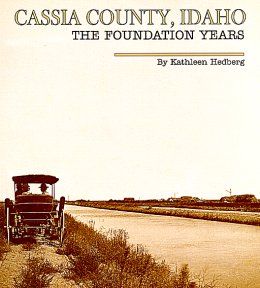 |
THE CASSIA COUNTY, IDAHO YEARS The first in a series of articles chronicling the adventures of young Edgar Rice Burroughs in America's "wild west." Featured in this installment are extracts from the book:
Photos from the ERB, Inc. Archives |
Extracts From Chapter 2: Early Settlers
Lew Sweetser--Cattleman and Miner
Andrew Sweetser was one of the early cattle ranchers in Cassia County. Arriving in the early 1870s with a herd of cattle from California, he and his various partners ran thousands of head of cattle in the Raft River Valley.His son Lewis "Lew" H. Sweetser was three years old when he joined his father in Idaho. Andrew was prosperous enough to send Lew to Yale University in 1885, where he met George and Harry Burroughs of Chicago. In 1890 Lew returned to Idaho with the Burroughs brothers where they formed a cattle company. The Cassia County record book noted that "Sweetser and Burroughs, Dealers in Livestock," had purchased 320 acres from "Sweetser Brothers and Pierce" for one dollar.
The three established the Bar Y ranch, named for Yale University. Later a post office named Yale was also established there. They were operating the ranch in 1891 when George and Harry's younger brother Edgar Rice Burroughs arrived to work on the ranch for a short time.
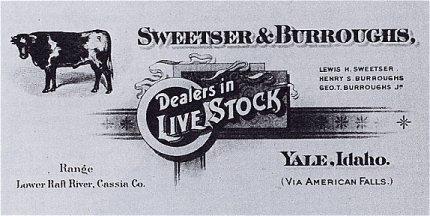
Copyright ERB, Inc.
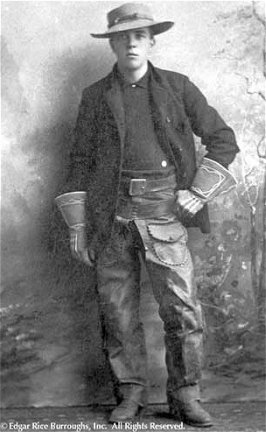
Ed Burroughs: The Teenage Cowboy |
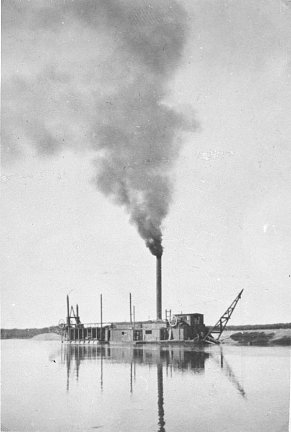
The Sweetser & Burroughs Gold Mining Dredge |
By 1897 with an overstocked range and less profit in ranching, Burroughs and Sweetser turned to mining. They had seen miners along the banks of the Snake River using pans or rockers to extract the fine gold dust. Thinking that there must be a better way, they formed the Yale Dredging Company, later the Sweetser and Burroughs Mining Company, and built a dredge to mine the river. The dredge was "a platform like contrivance with a towering funnel, containing a suction hose to draw up the gravel, sand and gold. At the front of the dredge were tables covered with burlap; as the sand washed over the tables, the gold particles were left behind, caught in the burlap. The dredge worked up- or down-stream, floating through whatever open channels it could find, leaving large mounds of gravel in its wake." The mounds of sand and gravel became sandbars, visible during times when the water in the river was low.Burroughs and Sweetser also built a houseboat that accompanied the dredge. It provided headquarters for the company and a home for the Burroughs and Sweetser families and their workers. With sixteen rooms, including one large common room, the double-decker houseboat was an elaborate affair.
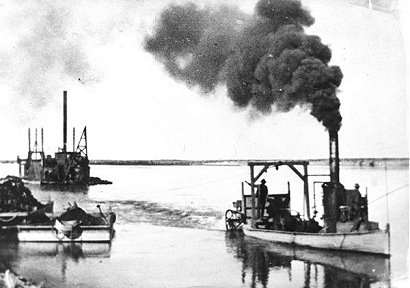
The dredge succeeded in extracting gold, and at first the Burroughs and Sweetser mining company prospered. Then Burroughs and Sweetser decided to try dredging in the Salmon River, but that venture failed completely. Lew returned to Cassia County where he raised sheep for a short time. In 1908 and 1910 he was elected Lieutenant Governor for the State of Idaho. In 1912 he returned to farming at Yale, becoming, in addition, a noted local writer and lecturer. In 1936 he and his wife Clara were vacationing in California when Clara died. Lew remained in California, where he died on June 9, 1944, a day after the death of his friend and former partner George Burroughs. Their bodies were cremated together.
Tarzan in Cassia County
Anyone living in the United States during the mid-twentieth century would have heard about the African adventures of Tarzan. From the time the first magazine story, "Tarzan of the Apes," was published in 1912, a steady stream of newspaper serials, magazine stories, books, and movies made Tarzan a household word.
Edgar Rice Burroughs, "the man who created Tarzan," wrote forty-seven other novels in addition to his twenty-eight Tarzan books, but his Tarzan books were the most famous. Over a period of fifty years, beginning with the silent picture, "Tarzan of the Apes," in 1918, forty Tarzan movies were produced.
Burroughs had never been to Africa, and his Tarzan books reflect nothing of African culture and history except the stereotypes of the times. But he did spend a few years in the West early in his life, and some people have suggested that his novels reflect his early Western experiences.
Burroughs first came West in the fall of 1891 -- and he came to Cassia County. He had come to live with his older brothers George and Harry on their ranch in the Raft River valley. He and his brothers were among the many emigrants who came West for their health.
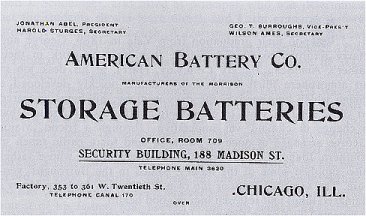
Copyright ERB, Inc.After graduating from Yale University in 1889, George and Harry worked at their father's American Battery Company in Chicago until Harry developed a cough from the battery fumes. A persistent cough was considered the precursor to lung damage and possible tuberculosis, a common and deadly disease. In those days before antibiotics, the sunny, dry climate of the West was prescribed as a prevention and cure for tuberculosis. The Burroughs brothers came to Cassia County where they joined Lew Sweetser in ranching.
Meanwhile Edgar, the youngest Burroughs brother, was not doing well in school and also appeared to have poor health. When in February 1891 an influenza epidemic broke out in Chicago, his father decided to send fifteen-year-old Edgar to join his brothers in Cassia County.
Edgar was fascinated by the people he met, and loved working with animals. "When I got my leg over a horse I owned the world," he wrote years later in his autobiography.
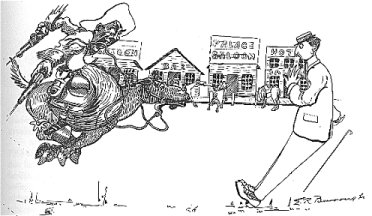
Idaho Cartoon by E. R. Burroughs ~ Copyright Edgar Rice Burroughs, Inc."I did chores, grubbed sage brush and drove a team of broncos to a sulky plow," he wrote. "I recall that once, after I unhooked [the team], they ran away and evidently, not being endowed with any too much intelligence, I hung onto the lines after tripping over a sage brush and was dragged around the country three times on my face."
Edgar was given the job of driving a wagon to the nearest railroad station at American Falls to pick up mail and freight. "The team that I drove consisted of two outlawed broncos;" he wrote, "one was locoed and the other was too mean to ride. One day the wagon went through a bridge and I had to go about five miles to a ranch house to borrow the necessary tools to get it out. Being a tenderfoot, a horse to me was a horse and not knowing anything about the past lives or reputations of either of the team I naturally climbed aboard the bad one and rode him bareback five miles to the ranch. Here I loaded up with shovels, picks and crowbars and climbed back onto the bronco, riding the five miles back to the stalled wagon with assorted hardware bumping him on all his corners, which goes to show that Providence really does look after a certain class of people."
Later he described riding a horse that was considered too mean to ride. The owner, Jim Pierce, told Edgar that if he could ride the horse, it would be his. He managed to ride him, and "stayed on him all that day because I was afraid if I got off I could never get back on again."
"At this time I learned... to take care of my horses, especially their backs, and I became proud of the fact that I never gave a horse a sore back, nor have I in my life." During a fall roundup he was given two horses with sore backs and both of them were healed while he was riding them.
Edgar lived at his brother's ranch for only about six months before he was sent home to complete his education, but he always remembered those days with fondness. "I slept on the floor of a log cabin," he wrote, "and in the winter time the snow drifted in under the door. When I got up at four o'clock in the morning to do the chores, I had only two garments to put on, my hat and my boots. The hat went on easy enough, but the boots were always frozen. I wonder why we recall such hardships as among the happiest experiences of our lives."
Seven years later he returned to Cassia County to work with his brothers on the Bar Y Ranch, but this time conditions were different. His brothers' cattle shipping operations had not been successful, and they did not have the money to hire him. He remained at the ranch for three months, then went to Pocatello where he operated a stationary store for six months, then returned to the ranch to work in the spring roundup. He left for the East a short time later.
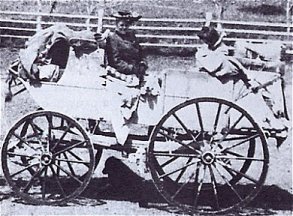
Photo Copyright ERB, Inc. Emma Burroughs on a stage coach in Idaho |
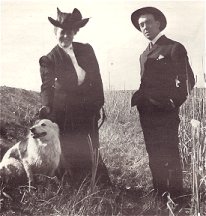
Photo Copyright ERB, Inc. ERB & Emma in Idaho |
Although Burroughs and his wife would later live for a short time in 1903 in Stanley and Parma, Idaho, he would never again live in Cassia County. His experience in Cassia County had been brief, but it had a great influence on his life. Irwin Porges, his biographer, notes that some poems he wrote while at Pocatello show that "the philosophy so repeatedly expressed by Ed in later years -- his bitter indictment of civilization and its destructive, degrading effects upon the simple natives and the animals," was already apparent. pp.72-73Others have noted that he may have transferred imaginatively his Idaho experience to his Tarzan and extraterrestrial stories. His first story, which was not published until after his death, was entitled, Minidoka 937th Earl of One Mile Series M. An Historical Fairy Tale. One of only two stories set in Idaho, it described two kingdoms that were "forever at war" separated by the Raft River. (p.89) Though the setting for his most of his other novels may have been far-off places, they reflected the influence of Cassia County on an impressionable boy.
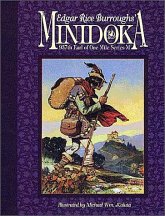
![]()
|
Cassia County, Idaho: The Foundation Years By Kathleen Hedberg
With a Ph.D. in history and the experience of growing up in Cassia County, author Kathleen Hedberg brings professionalism and an insider's view to her historical writing. Her book A Flood Cannot Happen Here won the Idaho Library Association award for 1993 for the best book on Idaho. |
|
Hardcover 8.5 x 11 inches, 256 pages Over 200 photos including 16 pages of color photos. Price: $30.00 Shipping: $6.00 Tax: Idaho Residents Add 5% Sales Tax ($1.50) Total: $36.00 Total Idaho Resident: $37.50 Order by e-Mail:
|
Cassia County Courthouse Recorder's Office 1459 Overland Avenue Burley, Idaho Order By Mail
|
![]()
![]()
When Edgar Rice Burroughs was just 14 and living in Chicago, he proposed to Emma Centennia Hulbert, daughter of a big-time hotel man in Chicago and St. Louis. She said "No." He kept asking Emma to marry him for the next 10 years - while he was in school, out West in Idaho, or in the Army. The answer was always "No!" Little did she know that one day her schoolboy chum would be the creator of one of literature's most enduring characters - Tarzan. But finally, Emma said "Yes," and then began a roller-coaster life of hard times, fame, fortune and misfortune. 
Tarzan missed Idaho,
but his creator didn't
CDApress.com ~ November 24, 2013Edgar was born in Chicago in 1875, fourth son of a Civil War veteran. A natural talent for writing showed itself early when the youngster was only five, writing his first poem:
"I'm Dr. Burroughs come to town,
To see my patient Maria Brown."He attended school in Chicago but when a flu epidemic broke out in 1891 and schools shut down, he was sent to Idaho to work on a cattle ranch near Pocatello, owned by two older brothers. There, the teenage cowboy became an excellent horsemen, riding a wild gelding named Whisky Jack that no one else could handle, and living among colorful characters like Hank Monk the cook, Sam Lands, teller of tall tales, and Texas Pete who was shot by Sheriff Gum Brown. Literary Digest wrote: "He was having a gorgeous time among cowpunchers, murderers, horse thieves, and bad men, when the claims of orthodox education asserted themselves and he was shipped east to Phillips Academy, Andover."
Next, he became a cadet at Michigan Military Academy where he was "noted for his rebelliousness." He ran away from school and caught a train back to Chicago, but was promptly returned. He eventually did well and graduated, then stayed on at the school for a short time as assistant commandant.
Edgar failed his entrance exam for West Point but joined the Army anyway as an enlisted man. His military career was short-lived however, when he was released after being diagnosed with a heart problem. (Later in life he joined the Army Reserves, attaining the rank of major.)
Then it was back to Idaho to start a stationery store business in Pocatello, financed by one of his brothers. It failed, so he returned to Chicago to work in his father's battery company, paying him $15 a week. That's when he married Emma. Borrowing $300 from his brother Coleman, the couple returned to Idaho, settling in the Stanley Basin on the Salmon River, where they lived on a houseboat and Edgar worked for his brothers dredging for gold. It was during those Idaho days that Edgar wrote his first fiction - Minidoka 937th Earl of One Mile Series M - a story never published in his lifetime. His next job was working for a railroad out of Salt Lake City throwing bums and hobos off trains. He hated it.
A string of non-descript jobs followed - timekeeping, selling light bulbs, candy, and pencil sharpeners, and peddling a published lecture series door-to-door.Things improved somewhat with accounting work in Chicago, followed by a stint with Sears Roebuck, where he was well appreciated.
In 1908, Edgar and Emma had their first child Joan (later "Joanne"), followed by Hulbert and Jack. Finances were still a problem for Edgar and Emma. Leaving a secure job at Sears to start an advertising agency was a mistake. It flopped and Edgar pawned his wife's jewelry to survive.
He started reading pulp fiction and felt he could write better. Reflecting on those times years later, he believed, "If people were paid for writing rot such as I read in some of those magazines, that I could write stories just as rotten." At age 35, his first writing paycheck came for his science-fiction story Princess of Mars. "No amount of money today could possibly give me the thrill that first $400 check gave me."
On Dec. 1, 1911 at 8 p.m. Edgar Rice Burroughs begins writing Tarzan of the Apes - longhand. He finishes the story at 10.25 p.m. on May 14, 1912, and a legend was born. It earned him $700.
From Chapter One: "A certain young English nobleman, whom we shall call John Clayton, Lord Greystoke, was commissioned to make a peculiarly delicate investigation of conditions in a British West Coast African Colony from whose simple native inhabitants another European power was known to be recruiting soldiers for its native army, which it used solely for the forcible collection of rubber and ivory from the savage tribes along the Congo and the Aruwimi ..."
Chapter Three: "That night a little son was born in the tiny cabin beside the primeval forest, while a leopard screamed before the door, and the deep notes of a lion's roar sounded from beyond the ridge. "Lady Greystoke never recovered from the shock of the great ape's attack, and, though she lived for a year after her baby was born, she was never again outside the cabin ..."
Chapter Four: "As (the ape) took up the little live baby of Alice Clayton she dropped the dead body of her own into the empty cradle ... "High up among the branches of a mighty tree she hugged the shrieking infant to her bosom, and soon ... the tiny man-child's half-formed understanding ... became quiet."
Chapter Five: "As Tarzan grew he made more rapid strides, so that by the time he was ten years old he was an excellent climber, and on the ground could do many wonderful things which were beyond the powers of his little brothers and sisters."
As the years rolled by, Burroughs wrote many sequels of the Ape Man story - as well as other tales. Tarzan appeared in books, movies, magazines and comic strips, and on radio. Then dark clouds appeared in his life. He began to suffer from painful neuritis, frightening nightmares, heart problems and other ailments. And he was continuously plagued by financial ups and downs - even when he was famous. Time and again, magazines and book publishers rejected his work, but he was a prolific writer and made enough sales to keep going.
It wasn't until 1917 that his first story was made into a movie - The Lad and the Lion. He received $500. In 1919, the Burroughs family moves from Illinois to California and bought a 540-acre country estate in the San Fernando Valley. He named it Tarzana.
In 1932, five-time Olympic Gold Medalist Johnnie Weissmuller appeared in the movie Tarzan the Ape Man, the first of 12 Tarzan movies he would star in. Many consider him the greatest Tarzan of them all. Who could forget Weissmuller wrestling a crocodile, or swinging from vine to vine through the trees, hollering his distinctive Tarzan yell calling his elephant pals to help fight the villains?
Then family troubles emerged, with Emma developing a drinking problem, and Edgar seeking comfort with Florence Dearholt, wife of friend and business associate Ashton Dearholt - whose marriage was also on the rocks. Both couples divorced their respective spouses, and in 1935 Edgar married Florence in Las Vegas. By the 1940s, Edgar and Florence were living in Hawaii, where Edgar fell into depression and drinking, possibly brought on by incessant criticism from critics and acquaintances, denying him the literary respect he sought. One night, the couple was dining in a Honolulu restaurant at the same time as Idaho's Ernest Hemmingway and his wife. Florence insisted her husband say hello to the great writer, but he wouldn't.
His second marriage crumbled, once more ending in divorce. Edgar never married again. Returning to California, he bought a house in Encino, as his health continued to decline. He died on March 19, 1950, after eating breakfast in bed while reading the Sunday comics.
He wrote 25 Tarzan books and 43 other novels - including The Bandit of Hell's Bend, a western based on his experiences in Idaho and Arizona. Late in his life, he wrote: "An English reviewer stated that I had the mind of a child of six. I hope he is right - and if he is, I thank God ... may it always be active and interested in many things ... simple things, from which I believe, we derive the truest happiness."
![]()
![]()
![]()
![]()

![]()
BILL
HILLMAN
Visit
our thousands of other sites at:
BILL
AND SUE-ON HILLMAN ECLECTIC STUDIO
ERB
Text, ERB Images and Tarzan® are ©Edgar Rice Burroughs, Inc.-
All Rights Reserved.
All
Original Work ©1996-2005/2010/2017 by Bill Hillman and/or Contributing
Authors/Owners
No
part of this web site may be reproduced without permission from the respective
owners.